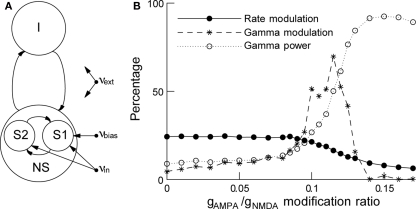Figure 3.
In attention, rate and gamma modulations are not concomitant effects. (A) Schematic representation of the network. The network consists of excitatory and inhibitory spiking neurons, with full synaptic connectivity. All neurons receive as external inputs (Poissonian) spike trains characterized by their rate. The excitatory neurons are organized in three pools: the non-specific neurons (NS) and the two selective pools (S1, S2) that receive the input encoding the stimulus (with rate νin). One of the two selective pools gets an additional bias (νbias). All neurons get also an input (νext) that simulates the spontaneous activity in the surrounding cerebral cortex. (B) Rate modulation (solid curve) and gamma modulation (dashed curve) as a function of the modification ratio gAMPA/gNMDA for excitatory synaptic conductances. Increasing this ratio increases rhythmic gamma band power (dotted curve), decreases the rate modulation monotonically while gamma modulation peaks around gAMPA/gNMDA ≈ 0.12. Either of the two modulations can be dominant, depending on the gamma power. Figure adapted from Buehlmann and Deco (2008).

